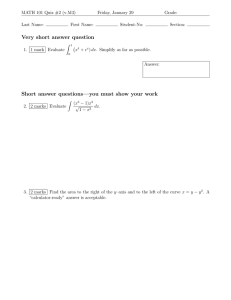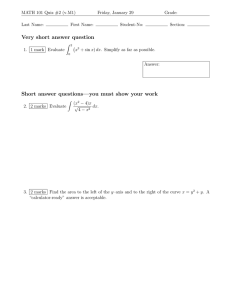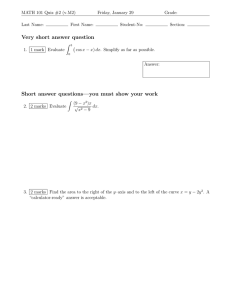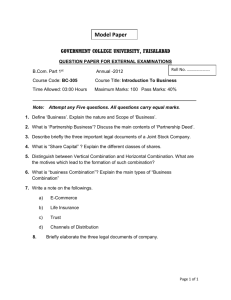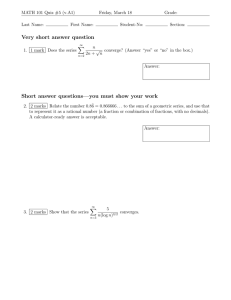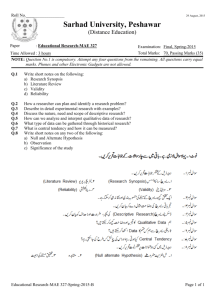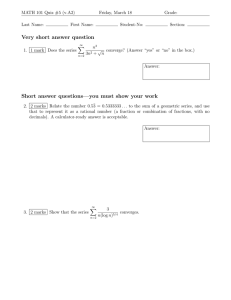9772 ECONOMICS MARK SCHEME for the May/June 2014 series
advertisement
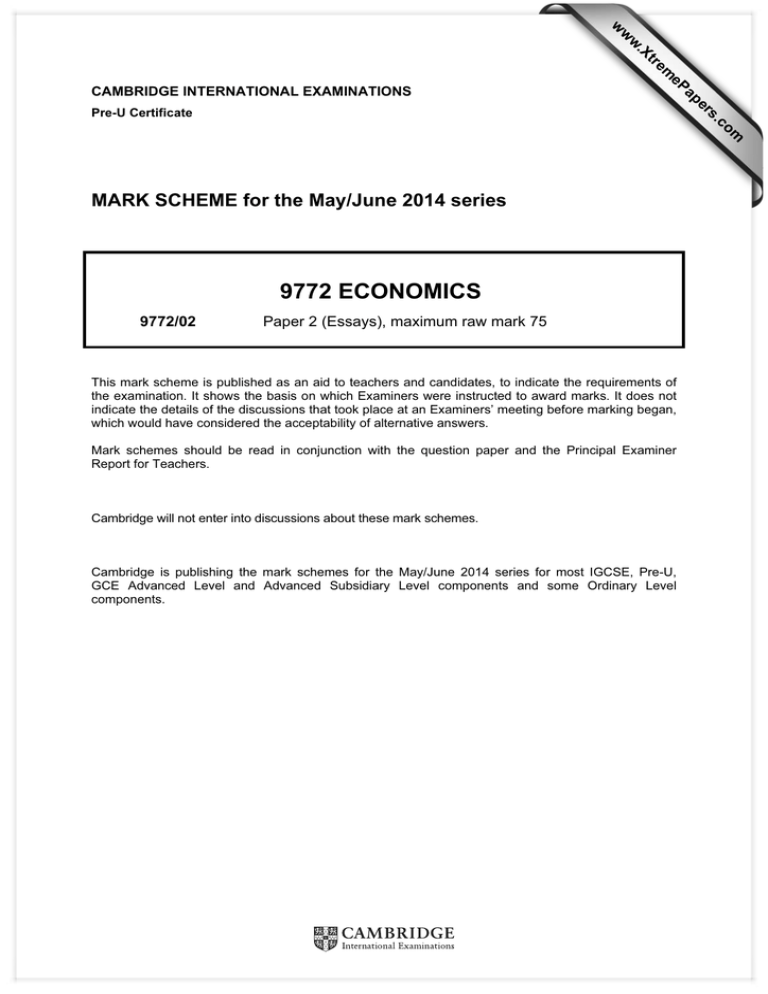
w w ap eP m e tr .X w CAMBRIDGE INTERNATIONAL EXAMINATIONS s er om .c Pre-U Certificate MARK SCHEME for the May/June 2014 series 9772 ECONOMICS 9772/02 Paper 2 (Essays), maximum raw mark 75 This mark scheme is published as an aid to teachers and candidates, to indicate the requirements of the examination. It shows the basis on which Examiners were instructed to award marks. It does not indicate the details of the discussions that took place at an Examiners’ meeting before marking began, which would have considered the acceptability of alternative answers. Mark schemes should be read in conjunction with the question paper and the Principal Examiner Report for Teachers. Cambridge will not enter into discussions about these mark schemes. Cambridge is publishing the mark schemes for the May/June 2014 series for most IGCSE, Pre-U, GCE Advanced Level and Advanced Subsidiary Level components and some Ordinary Level components. Page 2 Mark Scheme Pre-U – May/June 2014 Syllabus 9772 Paper 02 The purpose of the essay paper is to enable candidates to select appropriate economic models, theories and concepts which they can then successfully apply to the circumstances of the question to produce good, logical arguments and draw conclusions. Higher scoring essays are likely to have a conclusion that may recognise that various answers are possible, or that it is not possible to draw firm conclusions in all cases. Full justification should be given for the conclusions drawn. The questions are set deliberately to require candidates to plan and structure their answer. Candidates should try to illustrate their arguments with recent and contemporary examples. Examiners should reward these examples appropriately. Certainly, a well-illustrated essay should score more highly than one which, while being sound in terms of the theory used, does not draw on actual events. For each question, there follows a preamble which outlines what is expected from the candidates – always remember that an ‘unexpected but accurate approach’ must be rewarded. A general list of areas that may be included is then given, followed by an example of the sort of answer that would fall into each level of assessment, both in terms of Theory and Analysis and in terms of Evaluation © Cambridge International Examinations 2014 Page 3 Mark Scheme Pre-U – May/June 2014 Syllabus 9772 Paper 02 Marking criteria for Paper 2 For this paper, marks should be awarded in the two following categories. The first category covers the knowledge and understanding of relevant economics, how this is applied and how the information/issues are analysed (Theory and Analysis) and the second category covers the candidate’s evaluation of the issues involved (Evaluation). Examiners should aim to mark the essay holistically and should decide into which relevant Levels the answer lies. The Levels will not necessarily be the same for the two categories. Theory and Analysis Level 4 (13–17 marks) Mid mark 15 An excellent answer that shows an accurate and comprehensive application of the relevant theory. There will be in-depth and coherent analysis. At the top end of the level, there will be signs of real insight and/or originality, not typically expected to be seen at this level. Level 3 (9–12 marks) Mid mark 11 An answer that logically addresses the issues involved and generally shows a correct application of the relevant theory. An attempt is made at analysis and there is some depth or coherence but not necessarily both. Level 2 (5–8 marks) Mid mark 7 Some correct application of relevant theory will be shown, but there may well be inaccuracies contained within the answer. An appreciation of the need to analyse may be demonstrated, but there will be not much more than this. The answer is likely to lack any real coherence. Level 1 (1–4 marks) Mid mark 3 The answer contains something of relevance to the set question. However, theory may be misunderstood, or incorrectly applied. At this level, any analysis shown will be extremely superficial. Level 0 (0 marks) Nothing of any relevance to the set question is shown within the answer. Evaluation Level 3 (6–8 marks) Mid mark 7 There is an in-depth, coherent, comprehensive and well-balanced evaluation. At the top end of the level, there will be signs of real insight and/or originality, not typically expected to be seen at this level. Level 2 (3–5 marks) Mid mark 4 There is a definite attempt to consider various points of view or outcomes for different economic agents or distinction between short-run and long-run consequences etc., but the coverage of these is less than comprehensive. Level 1 (1–2 marks) Mid mark 2 There is some attempt at evaluation, but issues are more likely to be stated rather than examined. Level 0 (0 marks) There is no evidence of any evaluation whatsoever. © Cambridge International Examinations 2014 Page 4 Mark Scheme Pre-U – May/June 2014 Syllabus 9772 Paper 02 Section A 1 Of all the elasticities of demand, own-price elasticity of demand is of the greatest importance for firms. To what extent do you agree with this statement? [25] Candidates should show a good level of knowledge and an understanding of the theory behind elasticity of demand, both in terms of how the values are calculated and what they show but also what they imply/convey to a firm in terms of implications of different strategies that may be followed. Answers may include: Knowledge and understanding of the relevant theory such as: • The three ‘classic’ elasticities of demand – own-price, cross-price and income (although candidates may introduce different ideas such as an ‘advertising expenditure elasticity of demand). • A clear demonstration of how the values are calculated and explanation of what is shown by the sign and magnitude of a value. Application of the theory to demonstrate differences between elastic and inelastic (and unitary) own-price elasticity of demand and between substitutes/complements and normal/inferior goods. Analysis of theory Examples: • Link between own-price elasticity of demand and implications on Total Revenue of a change in price. • Discussion of how cross-price and income refer to changes in demand (i.e. shifts of demand curve) whereas own-price is to do with movements along a demand curve. Evaluation of the issues involved Examples: • Do firms have any real idea as to what these various concepts are/what they show/how they might be calculated? • Is the firm looking at the implications of its actions or those of other ‘agents’? • How do revenue implications feed through into the whole concept of ‘aims of firms’? • Does the importance vary depending upon the timescale that is being considered? • What do we mean by ‘greatest importance’? © Cambridge International Examinations 2014 Page 5 Mark Scheme Pre-U – May/June 2014 Syllabus 9772 Paper 02 Theory and analysis Level 4 (13–17 marks) Mid mark 15 There will be a clear and accurate explanation of the three main ‘elasticities’. Accurate diagrams, for example, may be used to explain how they relate to movements along/shifts of demand curves. At the top end of this level, candidates are likely to make a clear distinction between what the various values show and how a firm might use this information to their advantage. Level 3 (9–12 marks) Mid mark 11 The analysis contained will be predominantly accurate, but the candidate may fail to clearly make the link between the values themselves and their implications – for example, the reader may be left with the thought of ‘this is all great but so what, what does it all mean for the firm?’ Alternatively, the answer may be good in terms of implications for firms, but there will be a distinct lack of explanation of what the various values show/how they are calculated. Level 2 (5–8 marks) Mid mark 7 Any analysis is likely to be superficial in nature or will contain some inaccuracies. There will be no consideration of the implications of any of the values. It is possible that the candidate will only consider ‘own-price’ and therefore no comparisons will be made. Level 1 (1–4 marks) Mid mark 3 A very limited appreciation of the issues is shown. There will be inaccuracies or irrelevancies in any analysis, and there will most probably be a complete failure to recognise that the answer needs to focus on the information provided by an elasticity of demand. Evaluation Level 3 (6–8 marks) Mid mark 7 A good answer is likely to discuss issues such as: • How useful are the concepts in terms of reality and the running of a business? • How does the timescale involved affect the analysis? • Assuming that firms can calculate the relevant values, does it just give them knowledge or does it affect their future ‘conduct’? • Clear consideration of the use of the term ‘greatest value’ There is likely to be a conclusion drawn at the end to explain the candidate’s overall view – even if this is that there is no clear-cut answer. Level 2 (3–5 marks) Mid mark 4 One of the above will be discussed in detail, or a couple of points will be mentioned but only in a relatively superficial way. Level 1 (1–2 marks) Mid mark 2 There might be some appreciation that an evaluation could be carried out. Indeed, there might be the odd comment that suggests an area for potential evaluation, but the comment is not developed. For example: ‘Different elasticities will be of differing relevance at different times’. © Cambridge International Examinations 2014 Page 6 2 Mark Scheme Pre-U – May/June 2014 Syllabus 9772 Paper 02 In monopolistic competition firms produce a variety of products but cannot exploit consumers. Therefore monopolistic competition is the ideal market form. Evaluate this statement. [25] Candidates should show a good understanding of the model of monopolistic competition and must be able to link the long run equilibrium position to that of the view that profit maximising monopolists can continue to exploit consumers. Candidates should also be able to discuss why choice over homogeneity may or may not be seen as an advantage. Answers may include: Knowledge and understanding of monopolistic competition including: • Assumptions behind the model • SR versus LR cost/revenue/profit diagrams • Possible link with ‘contestable markets’ • Implications on allocative, productive and dynamic efficiency • Comparison with perfect competition and monopoly market structures. Application of theory to particular markets, with the use of examples such as restaurants, clothing stores, and convenience stores. Analysis of how supernormal profits will be competed away via the entry of other firms resulting ultimately in a ‘tangential’ normal profit position. Within the analysis, yet leading into definite evaluation, may be a discussion as to whether supernormal profits must necessarily be against the best interests of consumers. Evaluation of the issues involved Examples: • Why is product differentiation important? • The issue concerning whether a monopolist will not use supernormal profits to fund research and development etc./exploit economies of scale etc. and hence might actually be better for consumers? • Discussion of how monopolistic competition is not a feasible market form in certain circumstances – for example, with ‘natural monopolies’. • Discussion of how advertising used to try to convince consumers that there are differences between products might be a waste of scarce resources due, in reality, to the extreme similarities between them. © Cambridge International Examinations 2014 Page 7 Mark Scheme Pre-U – May/June 2014 Syllabus 9772 Paper 02 Theory and analysis Level 4 (13–17 marks) Mid mark 15 There is a clear understanding of the monopolistic competition model and an accurate explanation will almost certainly be given as to why the long run equilibrium situation results in normal profits for a firm. At this top level, there will need to be some analysis as to why this, and/or product differentiation, might be seen to be good for consumers, rather than just a statement of what will occur. Level 3 (9–12 marks) Mid mark 11 The candidate may either focus on just the characteristics of monopolistic competition or may perhaps focus on why a monopoly is seen as bad. Whilst the ‘analysis’ may be accurate enough, the response will not stay focused on the set question. Level 2 (5–8 marks) Mid mark 7 Whilst there may well be some appreciation of what is meant by monopolistic competition, there are likely to be errors or omissions in any diagrams produced by the candidate. Level 1 (1–4 marks) Mid mark 3 Definitions and/or diagrams are either missing or totally inaccurate. The answer will fail to address the question but may instead be a poor attempt to re-hash a textbook explanation, rather than writing an analysis of different market forms. Evaluation Level 3 (6–8 marks) Mid mark 7 A good answer is likely to discuss issues such as: • How realistic are the assumptions behind the long run equilibrium situation for monopolistic competition? • When might a monopolist be better for consumers? • Best market form for whom? • Is product differentiation actual or just perceived – does this matter? There is likely to be a conclusion drawn at the end, to explain the candidate’s overall view – even if the conclusion simply states that there is no clear-cut answer. Level 2 (3–5 marks) Mid mark 4 One of the above will be discussed in detail, or a couple of points will be mentioned, but only in a relatively superficial way. Level 1 (1–2 marks) Mid mark 2 There might be some appreciation that evaluation could be carried out. Indeed, there might be the odd comment that suggests an area for potential evaluation but the comment is not developed. For example: ‘A monopolistically competitive firm cannot exploit its position and so must be better.’ © Cambridge International Examinations 2014 Page 8 3 Mark Scheme Pre-U – May/June 2014 Syllabus 9772 Paper 02 Of all market failures, it is the problems caused by inequalities in the distribution of income with which governments need to be most concerned. To what extent do you agree with this statement? [25] Candidates should show a good understanding of the various forms of market failure, and in particular must be able to explain why inequalities in the distribution of income cause a market failure. The use of the phrase ‘most concerned’ in the question should indicate that the answer should evaluate the extent to which such problems are greater than other problems caused by market failure. Answers may include: Knowledge and understanding of the theory behind market failure and also, for better answers, a clear understanding of the principle of ‘effective demand’ and the need for both the willingness AND the ability to buy goods and services. Higher scoring answers will concentrate on the various problems which might be caused by the market failure, rather than on the market failure per se, in order to enable an evaluation to take place. In particular, the candidate should be able to explain that an inability to afford certain goods and services can be seen as a problem – and may well explain the difference between the inability to afford health care as opposed to the inability to afford a sports car. Application to real life – higher scoring candidates may well identify that health and education, as well as being classic examples of merit goods, are also two key areas in which an inability to consume would be seen as a problem in our society. Analysis of why governments need to be concerned Examples: • What would happen without any intervention? • Brief explanation of how the government intervention might resolve the problems – note that the question does not ask for a detailed explanation as to how exactly a government might intervene to deal with income distribution inequalities – so there is no need to explain how progressive tax and re-distributive benefit systems work. Evaluation of the issues involved might include the following examples • Some attempt to rank the various problems caused in terms of answering the ‘most concerned’ part. • A discussion of whether the degree of the ‘problem’ will depend upon a value judgment and how, in some countries, the government will not be as concerned with the problems associated with poverty. • A discussion of whether government intervention might have unintended consequences/ government failure – e.g. removing incentives to look after yourself if too much intervention and support from the government. © Cambridge International Examinations 2014 Page 9 Mark Scheme Pre-U – May/June 2014 Syllabus 9772 Paper 02 Theory and analysis Level 4 (13–17 marks) Mid mark 15 There is an understanding of why inequalities in the distribution of income can cause market failures, perhaps through the effective demand mechanism. The problems caused by this and at least another couple of market failures will be considered, although the essay will most certainly NOT read like a shopping list of ‘the causes of market failure’. At this level there will also be good use of relevant examples which clearly demonstrate the problems caused. Level 3 (9–12 marks) Mid mark 11 The candidate is likely to either focus just on the market failure caused by the inequalities in the distribution of income – albeit to a convincing level, or they will explain several causes of market failure without an adequate explanation of what the problems are that are caused and/or of whether governments can easily intervene. Level 2 (5–8 marks) Mid mark 7 There is an appreciation of what is meant by market failure but there are errors or omissions in the candidate’s answer. It is possible that the candidate is unable to explain why market failures are said to occur in this case, and the answer appears to have been written by someone hoping for a more general ‘market failure’ question. Level 1 (1–4 marks) Mid mark 3 Explanations are either missing or inaccurate. The answer is likely to fail to address the set question and instead makes a very weak attempt to re-hash a textbook explanation of market failure/government intervention. Evaluation Level 3 (6–8 marks) Mid mark 7 A good answer is likely to discuss issues such as: • How do we decide which is the area for most government concern? • Does the type of economic system affect not only whether the government might wish or not wish to intervene, but also its ability to intervene effectively? • Are there time issues to be considered? – perhaps considering preventative health care versus corrective healthcare? In a well structured answer it is likely that there will to be a conclusion drawn at the end to explain the candidate’s overall view – even if the conclusion states that it depends upon which aims the government of a particular country wishes to pursue. Level 2 (3–5 marks) Mid mark 4 One of the above will be discussed in detail or a couple of points touched on, but only in a relatively superficial way. Level 1 (1–2 marks) Mid mark 2 There might be some appreciation that evaluation could be carried out. Indeed, there might be the odd comment that suggests an area for potential evaluation, but the comment is not developed. For example: ‘The problems caused by inequalities in the distribution of income should certainly be one of the main concerns of any government.’ © Cambridge International Examinations 2014 Page 10 Mark Scheme Pre-U – May/June 2014 Syllabus 9772 Paper 02 Section B 4 With reference to current UK experience, evaluate whether tax and benefit systems inevitably have adverse effects on incentives to work, save and invest. [25] Candidates should show a good understanding of how governments raise taxes and also pay out benefits. The question requires answers to demonstrate some knowledge of the current system rather than just a theoretical justification, although the use of the word ‘inevitably’ in the question clearly points candidates in the direction of evaluating whether all systems must have effects on the incentives of all three points. Clearly there is scope for better answers to discuss the issue of what is meant by ‘adverse effect’. Answers may include: Knowledge and understanding of: • The different forms of taxation that can be used - e.g. on income, on wealth/savings, on profits and also on expenditure etc. • The rationale behind any benefit system – scope for discussion about ‘value judgments’ as to who should/does receive benefits. • The Laffer curve and incentives to work. • The unemployment trap. • The concept of ‘double taxation’ on savings. Application in terms of clear demonstration of how the system currently operates in the UK – rather than just generalisations. Analysis of the way different types of taxes have various impacts depending upon whom they are levied. Also candidates may well look at the different reasons why people receive benefits rather than trying to lump all benefit recipients in together. Examples: • Marginal rate of taxation versus average rate of taxation and incentives – the so-called ‘brain drain’. • Corporation tax and effect on retained profits/ability to invest. • MNCs and FDI and idea of where profits are declared. • Disincentive to save if interest gets taxed. • Idea of ‘make work pay’. • JSA versus family credit versus invalidity benefits – i.e. does it depend upon the type of benefit? • Is the aim of the benefit to provide short term assistance or a long term ‘safety net’. Evaluation of the issues involved Examples: • How different taxes affect different people in varying ways – e.g. with varying tax rates it possibly acts as an incentive for some and a disincentive for others. • Does the benefit depend upon the state of the economy? If there are no jobs available, benefits can hardly act as a disincentive to work. • Is it not the way in which tax revenue is raised that is all important? For example, a tax on expenditure would hardly act as a disincentive to work. © Cambridge International Examinations 2014 Page 11 Mark Scheme Pre-U – May/June 2014 Syllabus 9772 Paper 02 Theory and analysis Level 4 (13–17 marks) Mid mark 15 There will be a clear discussion of how the tax and benefit systems currently operate in the UK. There is likely to be a detailed analysis of how the three factors – work, saving and investment – are affected by various taxes that are/could be levied. A candidate may concentrate on the analysis of one of the three – most likely to be work – but to achieve this level there must be some acknowledgement of at least one of the other two. At the top of this level a candidate will be able to accurately discuss the current system in operation in the UK rather than just in theoretical terms and will also likely include discussions of alternatives that could be used that might have a different outcome to the current UK situation. Level 3 (9–12 marks) Mid mark 11 Knowledge of how the system works without a detailed analysis of how this affects incentives, or a good theoretical approach concerning incentives with only limited knowledge demonstrated of the tax and benefit system as currently operated in the UK. Level 2 (5–8 marks) Mid mark 7 There is likely to be very little detailed knowledge of the current system shown – just very generic terms like ‘progressive income tax’ – and also only limited analysis of the effect on incentives. Level 1 (1–4 marks) Mid mark 3 There is very little evidence shown that the candidate understands what is meant by a ‘tax and benefit’ system and no attempt is made to try to explain the current system in the UK. Evaluation Level 3 (6–8 marks) Mid mark 7 A good answer is likely to discuss issues such as: • Do incentives work the same way on all people? • Does the general state of the economy not also play a part in acting as an incentive/disincentive? • Is the word ‘inevitably’ not an overstatement? Does not the type of taxation/benefit affect where the disincentive falls? • If there must be a disincentive for one group, which would be the best for it to fall upon – workers, savers or investors? There is likely to be a conclusion drawn at the end to explain the candidate’s overall view – even if this is that there is no clear-cut answer. Level 2 (3–5 marks) Mid mark 4 One of the above will be discussed in detail or a couple of points touched on, but only in a relatively superficial way. Level 1 (1–2 marks) Mid mark 2 There might be some appreciation that evaluation could be carried out. Indeed, there might be the odd comment that suggests an area for potential evaluation, but the comment is not developed. For example: ‘We need to consider in what way tax revenue is collected before drawing conclusions’. © Cambridge International Examinations 2014 Page 12 5 Mark Scheme Pre-U – May/June 2014 Syllabus 9772 Paper 02 With a free floating exchange rate current account deficits on the balance of payment are never a major problem. To what extent do you agree with this statement? [25] Candidates should show a good understanding of the terms used in the question – in particular, ‘free floating exchange rate’ and ‘current account deficit on the balance of payments’. Moreover, good answers will need to consider the use of the phrase ‘never a major problem’. Answers may include: Knowledge and understanding of what a free floating exchange rate is (as opposed to a managed or fixed exchange rate). Application and explanation of how a deficit should lead to a fall in the exchange rate leading to a rebalance of exports earnings/import payments to ‘correct the deficit’. Analysis of how the mechanism works Examples: • Changes in relative price competitiveness for both exported and imported goods and services. • Time lag issues – and there may well be scope for discussion of Marshall Lerner conditions. • Other factors that go towards determining a country’s exchange rate. Evaluation of the issues involved Examples: • Is a deficit always ‘a problem’ – short run versus long run/capital items versus consumer items? • Which other factors affect the exchange rate in reality – can it ever be truly ‘free floating’ or is there some limit to how far an authority will let its currency move relative to other currencies? • Is the use of the word ‘major’ of significance? Is it the lesser of several potential evils? Theory and analysis Level 4 (13–17 marks) Mid mark 15 There is likely to be a clear, precise and accurate explanation of how a free floating exchange rate is expected to ‘deal with’ a current account deficit on the B of P through analysis of the demand and supply of the relative currencies and hence the ‘price’ of the currencies in relation to each other – namely the exchange rate. There may well be a good numerical example to demonstrate the changes in X and M as a result. It will need to be clearly explained that it is the revenues earned from/spent on exports and imports that is of importance rather than just ‘physical quantities’ and, almost certainly, better answers will cover the concept of the Marshall Lerner condition, even if it is not explicitly mentioned by name. At the top end, there is likely to be some consideration of what brought about the original deficit and how this fact might have implications as to how it might be tackled (also can be covered in evaluation). © Cambridge International Examinations 2014 Page 13 Mark Scheme Pre-U – May/June 2014 Syllabus 9772 Paper 02 Level 3 (9–12 marks) Mid mark 11 It is likely that there will be a reasonable understanding demonstrated of what is meant by a current account deficit on the balance of payments and of how price competitiveness is a combination of both the ‘home price’ and the exchange rate. Also, it is likely that the answer will touch upon how a change in the exchange rate, ceteris paribus, can change relative price competitiveness, but the analysis is unlikely to go into much depth. Level 2 (5–8 marks) Mid mark 7 The answer is likely to be relatively superficial and there will be limited explanation either of what may have brought about the deficit or of how changes in the exchange rate might ‘improve’ the situation. Level 1 (1–4 marks) Mid mark 3 There will be little of any relevance. The answer may well suggest that the candidate is somewhat confused between a trade deficit and a budget deficit. Evaluation Level 3 (6–8 marks) Mid mark 7 A good answer is likely to discuss issues such as: • Does a country need to worry about such a deficit – are they ‘homogeneous items’? • How does the timescale involved affect one’s views as to whether there is a problem. • Will countries ever be happy to let their currency be totally ‘free floating’? There is likely to be a conclusion drawn at the end of the answer, to explain the candidate’s overall view – even if it states that there is no clear-cut answer. 6 Level 2 (3–5 marks) Mid mark 4 One of the above will be discussed in detail or a couple of points touched on, but only in a relatively superficial way. Level 1 (1–2 marks) Mid mark 2 There might be some appreciation that evaluation could be carried out. Indeed, there might be the odd comment that suggests an area for potential evaluation, but the comment is not developed. For example: ‘Of course, not all deficits are the same’. The Human Development Index [HDI] is of far greater significance to citizens of LEDCs whereas governments in MEDCs are inevitably more concerned with GDP per head figures. Evaluate this statement [25] Candidates should show a good understanding of what is meant by all the various terms used in the question. It is highly likely that the answer will expand into some form of discussion on the broader concept of ‘quality of life’. Answers may include: Knowledge and understanding of the HDI – at least in general terms (candidates should not be penalised for not knowing every minute detail of the relatively recent changes in way the figures © Cambridge International Examinations 2014 Page 14 Mark Scheme Pre-U – May/June 2014 Syllabus 9772 Paper 02 are calculated). There needs to be a good understanding shown of the concept of GDP per head. An appreciation of what these figures demonstrate will almost certainly be necessary for an answer to reach above level 2 for Theory and Analysis. Application of how the various figures may be used in terms of inter-country comparisons or in terms of working out areas where aid may be needed. Analysis of how the figures are used and also what they show Examples: • Problems with GDP per capita and income distribution. • Standard of living versus quality of life issues. • What use is made of the figures? • Use of word ‘inevitably’ in second part of question – with what other figures might an MEDC Government be concerned? Evaluation of the issues involved Examples: • How accurate are the various statistics – particularly for LEDCs? • Calculating statistics in themselves does not help feed people so what is the point of having any statistics? • What about the ‘variables’ that are not included in either measure – human rights, political freedom, freedom from fear of war etc. • Wording of question – citizens of LEDCs as opposed to Governments of MEDCs – relevance? Theory and analysis Level 4 (13–17 marks) Mid mark 15 There is a clear and accurate understanding shown of which factors are included in the Human Development Index – and there may well be some ‘historical background’ to its introduction to explain its importance. At the top end, candidates may be able to explain the 2011 changes made, namely, concerning the years of schooling as opposed to adult literacy rates combined with education enrollment ratios. Candidates will almost certainly focus on the fact that both measures make use of ‘standard of living’ as measured by output per head figures and so will concentrate upon why the inclusion of extra variables may be of importance to citizens of LEDCs. A discussion of the potential pitfalls for both sets of statistics is likely to be evident at this level. Better answers may well discuss MEDCs meeting ‘minimum standards for other variables’ and hence having more ‘freedom’ to pursue material well-being. Level 3 (9–12 marks) Mid mark 11 There will either be a good understanding of the difference between the two measures but with little discussion of the implications of such differences in the context of the citizens of LEDCs and the Governments of MEDCs or there will be a reasonable discussion of the implications of the differences without any explicit display of an understanding of what ‘extras’ are included in the HDI. Level 2 (5–8 marks) Mid mark 7 Any analysis is likely to be rather superficial and there will be limited knowledge shown of the difference between the two measures. © Cambridge International Examinations 2014 Page 15 Level 1 (1–4 marks) Mid mark 3 Mark Scheme Pre-U – May/June 2014 Syllabus 9772 Paper 02 There will be little of any relevance. The answer may well discuss more important issues than just output per head but will fail to examine this view and will show no signs of how the HDI is calculated. Evaluation Level 3 (6–8 marks) Mid mark 7 A good answer is likely to discuss issues such as: • The difference between a country’s HDI figure and what this figure actual means, both now and in the longer run, for its citizens. • ‘Lies, damned lies and statistics’ idea – what does any statistic really mean? • Should countries, whether LEDCs or MEDCs, just be concerned with themselves? Due to globalisation and the inter-dependence of world economies, is it not in everyone’s best interests for all economies to flourish? • Is it not it the issues involved in determining the HDI that matter rather than merely the aggregation of a set of numbers? • What about the environment? There is likely to be a conclusion drawn at the end to explain the candidate’s overall view – even if it states that there is no clear-cut answer. Level 2 (3–5 marks) Mid mark 4 One of the above will be discussed in detail or a couple of points touched on, but only in a relatively superficial way. Level 1 (1–2 marks) Mid mark 2 There might be some appreciation that evaluation could be carried out. Indeed, there might be the odd comment that suggests an area for potential evaluation, but the comment is not developed. For example: ‘It may be that figures from LEDCs are highly inaccurate.’ © Cambridge International Examinations 2014
